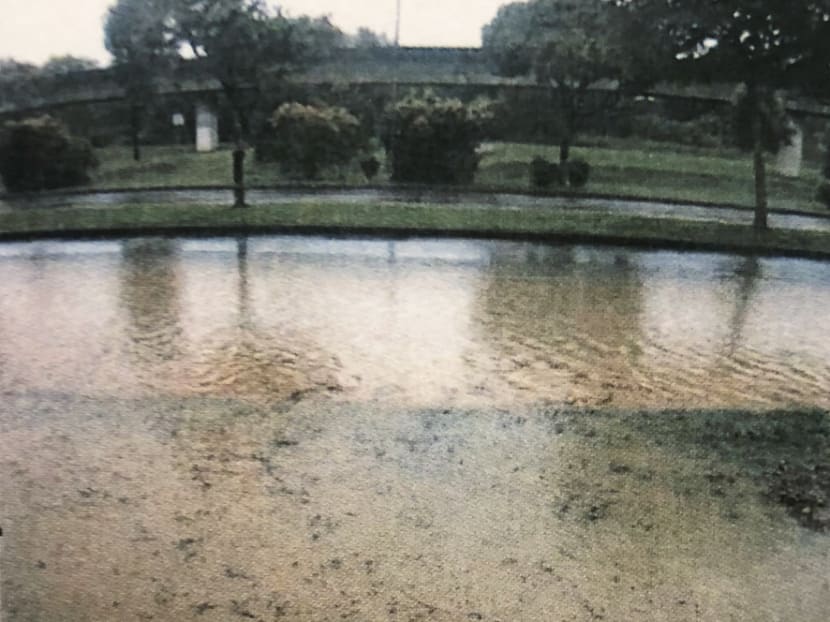Obstructed earth drain worsened flash flood at Tampines Ave 12
SINGAPORE ― A temporary road built by a Housing and Development Board (HDB) contractor obstructed a ditch near Tampines Ave 12, worsening the flash flood there on Jan 8, national water agency PUB said on Wednesday (Jan 17).

Flash flood was caused by intense rainfall which overwhelmed the "design capacity" of the drain along Tampines Ave 12. Photo: PUB
SINGAPORE ― A temporary road built by a Housing and Development Board (HDB) contractor obstructed a ditch near Tampines Ave 12, worsening the flash flood there on Jan 8, national water agency PUB said on Wednesday (Jan 17).
The area was one of nine locations in eastern Singapore hit by flash floods on Jan 8.
But PUB launched an investigation because it was unlike the other affected locations, which are relatively low-lying and where drainage improvement works are due to be completed by the first quarter of next year.
PUB said the Tampines Ave 12 flash flood was caused by intense rainfall that morning, which exceeded the capacity of the roadside drain.
The situation was “aggravated” by the storm runoff from an adjacent site, said PUB in a media statement after it wrapped up investigations.
A ditch, or earth drain, near the construction site for an HDB development was supposed to help channel away some of the rain water.
But it was blocked by a temporary construction access road that construction firm Huationg Contractor built across it. This caused the storm runoff to overflow into the drain along Tampines Ave 12.
An earth drain is usually found in areas that are not developed, such as forested areas, to manage the drainage in these places.
The HDB said the construction site was for earthworks to prepare for upcoming developments in the area.
Huationg has explained that it did not seek PUB’s approval to build construction access over the existing earth drain as the drain appeared abandoned. HDB was not aware of it, said a spokesperson.
The HDB’s tender specifications clearly require all contractors to comply with PUB’s Code of Practice on Surface Water Drainage at all times during construction works. Such sites require the contractors to engage a Qualified Erosion Control Professional to design the earth control measures and seek PUB’s approval before the commencement of work, among other things.
“HDB is conducting an investigation and will take action against the contractor accordingly,” the spokesperson said.
Asked if the contractor would be penalised, PUB said further investigations would be needed.
If found guilty under the Sewerage and Drainage Act, offenders may be fined up to S$50,000 for works affecting the public drainage system.
Last December, contractor Sato Kogyo was fined S$14,000 for unauthorised works that contributed to flash floods along Thomson Road on Christmas Eve in 2016. The Japanese firm was one of the 14 contractors and two qualified persons penalised last year for drainage offences and failing to supervise drainage work.
The heavy downpour on Jan 8 was due to the prevailing North-east Monsoon and made worse by an unexpected Sumatra squall — sudden thunderstorm lines – that developed over the Straits of Malacca.
The heaviest rainfall of 118.8mm was recorded at Kim Chuan Road that day, which amounted to roughly half of Singapore’s average monthly rainfall in January.
The flood at Tampines Ave 12 lasted about 25 minutes, from 9.50am to around 10.15am.
PUB director of the catchment and waterways department Yeo Keng Soon said on Wednesday that the agency would try to remove the obstruction by the end of the week, and is working with the HDB and Huationg to improve drainage in the area.
A permanent drainage system will be built together with the future development at the site.
Drains in Singapore are able to cope with the rainfall, but flash floods can occur when there is an extreme storm or heavy rain which exceeds the drains’ capacity, said Mr Yeo.
“While PUB will continue to improve our drainage system, it is not practical to design our drains to accommodate every extreme storm… Doing so would lead to significantly higher costs and will take up a whole lot more land,” he said.
This expanded drain capacity is also not required most of the time, he added.






